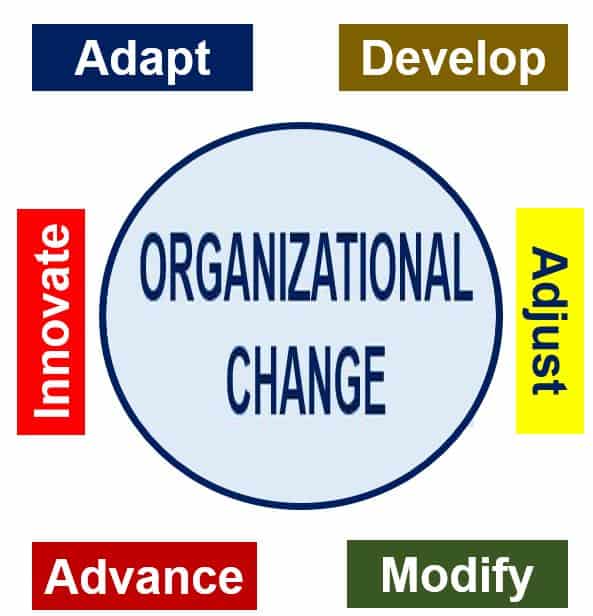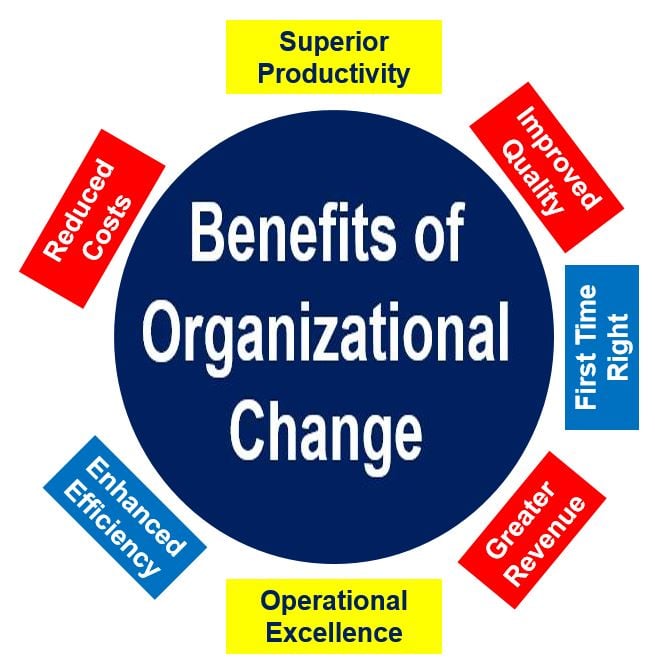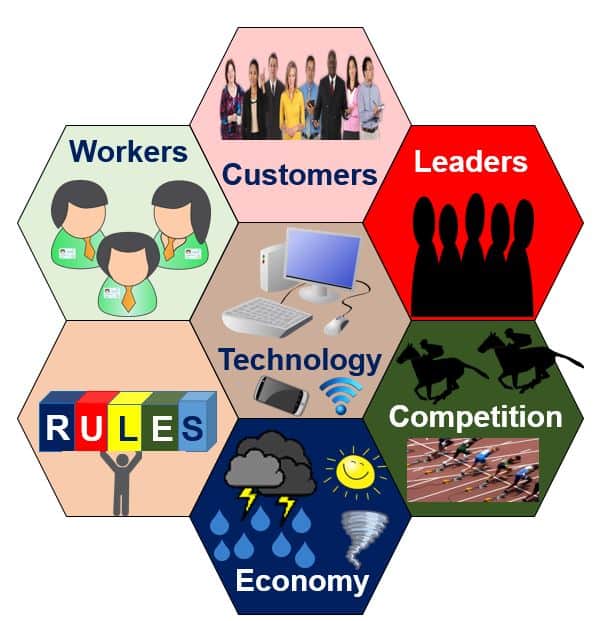Organizational Change looks at the process in which a company or any organization changes its operational methods, technologies, organizational structure, whole structure, or strategies, as well as what effects these changes have on it. Organizational change usually happens in response to – or as a result of – external or internal pressures.
Such transformations require a strategic approach to ensure alignment with long-term objectives and to maximize the positive impact on the organization’s performance.
It is all about reviewing and modifying structures – specifically management structures – and business processes.
Small commercial enterprises need to adapt to survive against larger competitors. They also need to learn to thrive in that environment. Large rivals must adapt rapidly when a smaller, innovative competitor comes onto the scene.
To avoid falling behind, or to remain a step ahead of its rivals, a business must seek out ways to operate more efficiently. It must also strive to operate more cost-effectively.

Ever since the advent of the Internet, the business environment today has been changing at a considerably faster pace compared to forty years ago. Organizational change is a requirement for any business that wants to survive and thrive.
Organizational change – embrace it!
Change is something that should be embraced rather than feared. Only with change will businesses be able to lay the foundations for long-term success.
Organizational change drivers
An organization’s change drivers include:
-
The economic climate
The term ‘economic climate’ means the state of the overall economy, i.e., economic conditions.
If there is a recession, a company may have to lay off workers; this requires restructuring.
A merger or takeover also means total reorganization and changes in corporate culture.
Corporate culture or organizational culture is a group of internal values and behaviors within an organization.
-
Consumer demand & behavior
People’s lifestyles and how they shop, work, and spend their leisure times are forever changing. Since the advent of the Internet, these changes have been occurring at significantly faster rates.

If you run a business today and hope that the pace of change will slow down, you will be in for a huge disappointment. Without change, your company will lose its competitive edge. It will also fail to meet the requirements of what most of us hope will be a growing base of loyal customers.
-
New technologies
New hi-tech systems and devices have completely changed how commercial enterprises do business and interact with other entities in the marketplace.
Business models such as virtual collaboration and outsourcing are only possible today thanks to the Internet and ultra-high-speed communications.
Without technological change, our business leaders would still be dictating correspondence to human beings, who would then type them out and arrange for them to be distributed to the relevant people – wasting an incredible amount of time and resources.
-
The competitive marketplace
If a new rival comes onto the scene with completely different commercial behaviors, the other players may have to adapt, especially if that competitor is successful in gaining market share.
-
Rules and regulations (government policy)
When companies are faced with new legislation or rules imposed by the relevant regulatory authorities, they need to do two things: 1. Comply with them. 2. Adapt so that they may continue to thrive.
Types of organizational change
What type of organizational change a company requires or is going through varies, depending on the person’s point of view.
A manager in technology may see it in terms of systems, tools, software, hardware, etc. The CEO will invariably perceive change in terms of structure and strategy.
The operations manager, on the other hand, will mainly see it in terms of processes, etc.
In the majority of cases, the change is so complex and intricate that nobody can define it fully from a specific standpoint.
Below are some of the common types of organizational change. Bear in mind that there is some or significant overlap between them:
-
Mission and Strategy
This is all about the company’s aims and goals and how it plans to accomplish them. Hardly any change in an organization is not related to its mission and strategy.
Mission and strategy affect every part of a business. Therefore, any change in this area has a company-wide impact.
-
Policies and Legal Agreements
Changing policies and legal agreements may be highly unpopular with customers and the workforce.
Any change in this area, even a minor one, may have a significant impact on a company.
-
Organizational Structure
The term refers to the hierarchy within an organization, which defines each job and department, their function, and where they report to.
When two commercial enterprises merge, or one takes over another, there are major structural changes. Sometimes the change may be minor, such as when a new team is established.
-
Processes
This term refers to a collection of linked tasks which find their end in the delivery of a product or service to a consumer.
Processes and tasks are commonly altered during organizational change. In some organizations, changing or upgrading processes is ongoing or occurs on a regular basis.
-
Personnel
Personnel means staff or human resources, i.e., the employees. It includes hiring, firing, training, roles, responsibilities, and other changes related to the workforce.
-
Culture
Culture refers to the pervasive beliefs, values, and attitudes that characterize a firm and guide its practices.
Any change in these areas can have a profound impact on every aspect of the organization.
It can have an impact on, for example, productivity, compliance, and innovation.
-
Products
This is all about changes to products, and everything related to encouraging consumers to buy them. Marketing and sales are an essential focus for most organizations.
-
Knowledge
Knowledge supports every product, process, initiative, project, and program. Change here refers to the knowledge assets of the company.
Knowledge assets are the information or skills within an organization that make it more competitive or valuable.
-
Technology
Today, virtually every commercial enterprise is a kind of tech company.
Sometimes, a company makes changes to its technology infrastructure, automation, systems, hardware, software, etc.
-
Integration
Integration includes synchronizing IT (information technology) and business cultures and objectives, aligning technology with company strategy and goals.
In a company, integration is a reflection of how people are absorbing IT as a function of the organization.
Virtually every change requires integration. We must align everything in a company so that they support, compliment, and add value to each other.
Integration is usually the most complex type of change. When carried out successfully, the whole company is clearly much more valuable than the sum of its parts.

Experts say that a fundamental aspect of introducing planned changes into any environment is to gain insights into how well they will be received by employees and customers and implemented by the management, and how accurately the economic climate today and tomorrow is perceived and forecast. Integrating technology across every component of the company and responding adequately to any new rules and regulations are crucial.
The study of organizational change
The study of organizational change, because of its very nature, covers some different disciplines, including psychology, management, economics, political science, and sociology.
There is no all-encompassing theory of organizational change that all experts refer or adhere to. Rather, it consists of several distinct theories that nobody so far has integrated.
Organizational change – failure
Perhaps this is why, in most cases, when people implement organizational change, it usually fails.
The key conclusion of a study – ‘Where Change Management Fails’ – by Robert Half Management Resources, which included 300 senior managers at US companies with at least 20 workers, was that organizational change usually fails.
The study found that in the majority of cases, the failure occurs in the executional phase. This is due mainly to broken or inadequate communication.
Forty-six percent of respondents said that most change-management efforts commonly failed at execution. However, only 10% claimed it occurred during the strategy development stage.
When asked what was most important when leading their company through a major organizational change, the respondents said:
- Communicating clearly and often: 65%
- Clearly outlining the goals: 16%
- Delegating effectively: 9%
Executive Director of Robert Half Management Resources, Tim Hird, explained:
“Whether major or incremental, many companies are initiating changes, from transforming their business models to updating business systems and looking for ways to enhance productivity. While change is never easy for a company, it’s even harder for employees.”
An organization is any group of organized people who work together and have a common goal.
To ensure the success of organizational change, it is crucial to foster a culture of adaptability and continuous learning among employees.
Additionally, engaging stakeholders throughout the change process can significantly enhance buy-in and reduce resistance.
Compound nouns with “organizational
The term “organizational change” is a compound noun, i.e., a noun consisting of two or more words. There are many compound nouns containing the word “organizational.” Let’s take a look at some of them, their meanings, and how they are used in a sentence:
-
Organizational Culture
The shared values, beliefs, and practices that shape the behavior and environment of an organization.
Example: “The new CEO is determined to shift the organizational culture towards more transparency and collaboration.”
-
Organizational Structure
The hierarchy and arrangement of job roles and responsibilities within an organization, defining how activities such as task allocation, coordination, and supervision are directed toward achieving organizational goals.
Example: “A flatter organizational structure has improved communication and decision-making processes within the company.”
-
Organizational Behavior
The study of how people interact within groups in a work environment, often used to apply knowledge towards improving an organization’s effectiveness.
Example: “Their research in organizational behavior has led to significant improvements in employee satisfaction and productivity.”
-
Organizational Performance
A measure of how efficiently and effectively an organization meets its goals.
Example: “Improvements in organizational performance were attributed to the recent restructuring and strategic initiatives.”
-
Organizational Development
A field of research, theory, and practice dedicated to expanding the knowledge and effectiveness of people to accomplish more successful organizational change and performance.
Example: “The consultant specializes in organizational development to help businesses manage transformation and growth.”
-
Organizational Strategy
The comprehensive plan by a business on how to operate and compete in the market.
Example: “The board meeting focused on refining the organizational strategy to navigate the rapidly changing industry landscape.”
-
Organizational Leadership
The management style and practices adopted by the leaders of an organization, influencing its direction and impact on its culture and performance.
Example: “Her approach to organizational leadership emphasizes empowerment, encouraging innovation and risk-taking among her team.”
